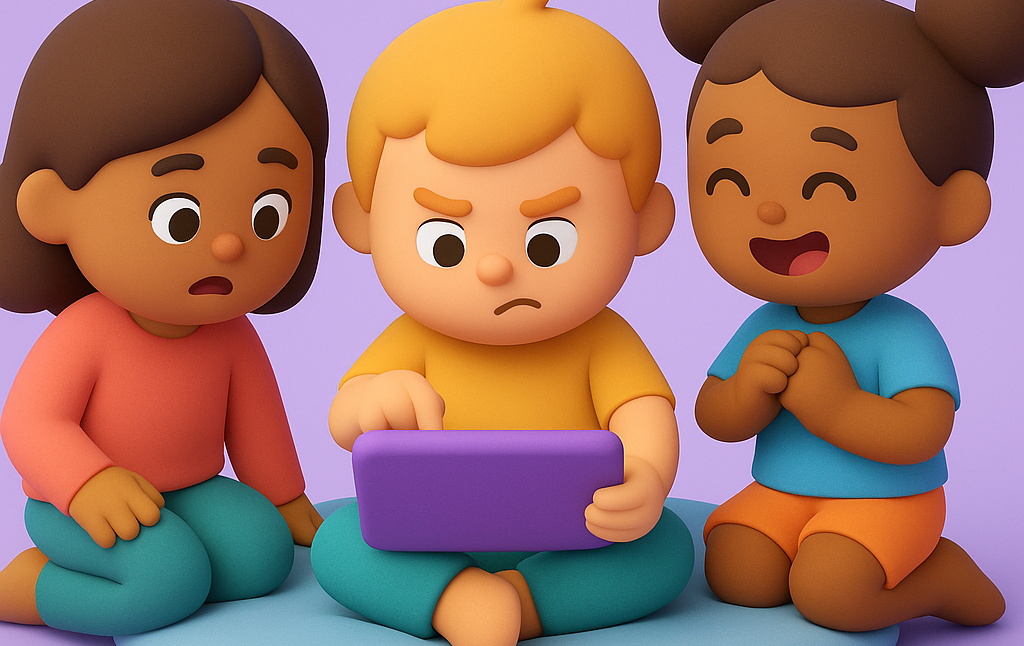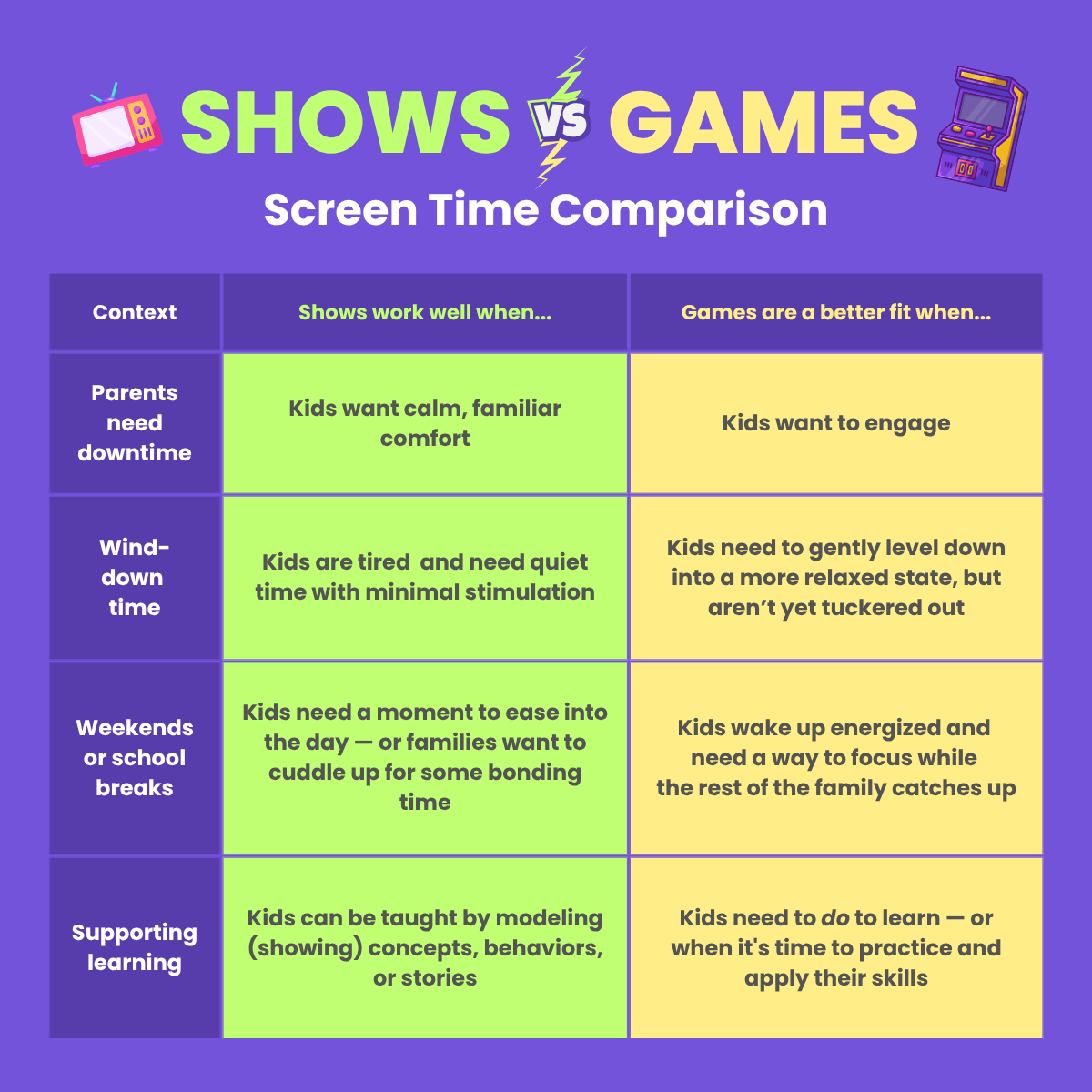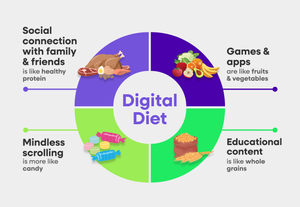As parents, we’re often concerned with limiting, monitoring, and curating our kids’ screen time. But instead of focusing on simple time limits, let's consider the kinds of screen time our kids are engaging in. Did you know there can be different benefits to different kinds of screen time?
I like to root this thinking in the Three Cs:
- Content: What is on the screen? Is it age-appropriate, engaging, or enriching?
- Context: Where, when, and how is the screen being used? Is it part of a routine, a social experience, or filling a gap? (By the way, all three of those options are totally valid!)
- Communication: Is the screen time accompanied by interaction between caregiver and child, between peers, or between the child and the content itself?
As a psychologist focused on the relationship between kids and digital gaming, I’ve found that video games and interactive apps can serve kids beyond just entertainment.
For example, let’s consider games. With the right game, screen time can be full of developmentally rich content that engages kids in a positive context of socialization, critical thinking, and creativity. It also encourages communication with in-game characters, online peers, or even explaining to their parents how to play (a fun switching of the roles that lets kids be the leader!).
Games and Shows Both Have Their Moments
This is why considering the kinds of screen time our kids are engaging in is important. Lumping all screen time together doesn’t reflect how kids actually use technology. Watching a show and playing a game might both happen on a screen, but they can serve different developmental functions. One encourages interaction, experimentation, and creativity. The other is more about comfort and consumption. Either can be a valid choice depending on those Three Cs, we just need to consider the impacts and outcomes associated with games versus shows.
Understanding the differences between active and passive screen time is one way digital parents (parents who embrace tech) can make more informed, less stressful choices. By comparing the roles and impacts of games vs. videos (shows, movies, YouTube shorts), you can see how digital play, especially through games, can become a powerful tool for learning, growth, and connection.
Active vs. Passive Screen Time: What’s the Difference?

Active screen time involves participation. It gets kids thinking, tapping, and otherwise interacting actively with what’s on the screen. It means doing and not just watching. For young kids, that often means:
- Video games or digital play
- App-based version of traditional board games
- Learning apps
- Interactive creative tools (like drawing or building apps)
- Video chatting with friends or family
- Videos or apps that guide physical activity (dance, exercise, play, etc.)
Passive screen time, on the other hand, is more about entertainment than engagement. Kids can consume passive media without much critical thought or interaction. Passive screen time might include:
- Watching shows or movies
- Scrolling through social feeds
- Watching short-form video, like YouTube
While this can still be beneficial in modeling concepts, behaviors, and situations that can still make a positive impact, it is not as engaging as more active options.
Screen Time to Support Development
Both can have a place in a balanced routine. But research consistently shows that active screen time supports outcomes in areas like:
- Language development
- Leadership skills
- Visual-spatial skills
- Self-regulation
- Social skills
- Critical thinking abilities
Meanwhile, passive screen time consumption may hinder comprehension and other verbal skill developments. However, passive screen time is still great for relaxing, learning, and bonding — snuggling up on the couch with a parent has its own benefits!
The gist of it is this: If kids are engaging their minds and bodies to react or interact to what’s on their screen, usually in active screen time situations, they’re actively supporting some kind of development. That’s why games for kids are such a rich opportunity for high-quality screen time.
→ Check out The Parent's Guide to Screen Time for Kids: What Research Reveals for more!
Why Games Offer a Better Kind of Screen Time
Games aren’t just a digital distraction. They’re interactive, goal-oriented, and designed to grow with the player. Unlike passive content, games require participation. Kids must make decisions, solve problems, and adapt to progress. Kids have to develop and apply their skills in order to progress through the game, earn rewards, and succeed through different levels.
A well-designed game meets a child at their current skill level and gradually increases difficulty. This technique is called scaffolded learning. It’s a powerful way to build competence and confidence. When done right, this also induces what psychologists call “flow” which is essentially being “in the zone.” You may even lose track of time!
But, when in this state of “flow,” learning is enhanced because you are hyper-focused on developing and improving, being optimally challenged, and having fun! Games are exceptionally good at fostering this.
Games also offer something hard to find in other parts of kids’ lives: the freedom to fail safely. There are no embarrassing classroom moments where they make mistakes in front of their peers. There are typically no social consequences. Games and apps offer kids a space to try, fail, and try again, developing resilience and tolerance for frustration along the way.
Games Let Kids Do What They Can't (Yet) Do Offline
Kids can also experience and do things that they can’t, or don’t often, do in non-digital spaces. For example, in games, children can lead teams, build entire cities, and try on new duties. They can build fantastical sculptures, race cars, battle dragons — live out imaginative fantasies, and build essential life skills along the way. They get to try on roles and responsibilities that would be out of reach in the non-digital world, all in a space designed for exploration and play.
And when playing together, these experiences flip the usual parent-child dynamic. Your kid becomes the expert. They explain how things work. They lead the way. That kind of role reversal builds confidence and gives kids a unique sense of accomplishment. Developing persistence, strategic thinking, logic, and memory skills can happen a lot easier for kids when they’re compelled to unlock the next whimsical world.
Cognitive Benefits of Digital Games for Kids
Games are incredibly rich environments for developing cognitive skills. They support executive functioning, like planning ahead, working memory, and pattern recognition. Kids are constantly making decisions, tracking progress, and adjusting their strategies in real time. Visual-spatial skills are constantly challenged and grown just by playing through interactive worlds.
Games also offer a playful way to engage with math and literacy. In Animal Crossing, for instance, kids earn money, pay off debts, and budget for new items, all while playing in a fun little animal world. And in games that require reading dialogue or following instructions, kids are practicing early literacy without it feeling like a chore.
There are even unexpected learning outcomes. I’ve heard stories from older kids with ADHD who said that games like The Sims helped them understand how to regulate their own needs. Watching the hunger or sleep meters drop in-game actually helped them tune in to similar feelings in their own bodies. That kind of intuitive, embodied learning can be incredibly powerful.
Emotional & Social Skills
Kids also get opportunities to grow emotionally and socially by using their screen time for gaming. Many games encourage turn-taking, cooperation, and communication — especially when siblings or friends are playing together. It’s a great way to practice teamwork, emotional regulation, and social problem-solving.

As I mentioned earlier, they also help kids develop frustration tolerance. You try, you fail, you try again, and each time, they learn something new. That process builds resilience and reinforces a growth mindset: the idea that you can get better with effort and persistence.
When parents get involved, games can give kids the opportunity to lead. Often, they’re the ones explaining how a game works or showing a parent what to do. That shift in roles — from learner to leader — is incredibly empowering for a child. Our brains often solidify things we’ve learned even better when we teach them to others. Not to mention the bonding experience this creates between parents and kids.
Creativity & Imagination
Of course, digital games can be a rich space for creative exploration with countless opportunities to expand and apply imagination. Many are structured around open-ended storytelling or world-building — think of games like Minecraft or The Sims, where the only limit is your kids’ imagination.
The concept of scaffolded learning comes up again here. In The Sims, for example, we’re not just handing kids a blank slate. We’re not just giving them a dollhouse and say, “OK, go play!” Instead, they’re given goals, stories, and other gentle nudges to make decisions, see what happens, solve problems, and try to achieve a certain goal or milestone.
For kids who struggle with unstructured pretend play, this can be a really supportive on-ramp to imaginative thinking. It’s still fantasy play, still involving plenty of imagination and make-believe, but it’s framed in a way that invites curiosity, storytelling, and experimentation.
Addressing Parental Concerns: Screen Time ≠ Mindless Play
It’s time to move beyond the idea that all screen time is equal or that games are just a way to kill time. Instead, we should ask: What does quality screen time mean to our kids? If it’s engaging, inspiring creativity, and getting their brain or body activated, it can be a super enriching experience, not just a way to entertain and unwind.
Not every game will be a good fit for every child. But that doesn’t mean we should write them off altogether. When evaluating games for your 4–7-year-old, consider:
- Is it age-appropriate and easy for them to navigate?
- Does it offer chances for co-play with siblings or adults?
- Does it let them explore, create, or practice skills?
Don’t be discouraged by games that aren’t labeled as "educational." Most games teach something, regardless, whether it’s math, cooperation, resilience, or storytelling.
When to Choose a Game vs. a Show
While we’re talking about this concept as “games vs. shows,” they’re not actually completely competing activities. Games, apps, shows, movies, and videos can all have their right time and useful purpose.
Think about the context of the screen time and what you and your kids might need in that moment.

Passive screen time can be comforting and bonding. Active screen time can be challenging and empowering. Both are valuable in different moments.
Embrace Gaming and Co-Play for Screen Time Connection
There’s still a place for passive screen time (like watching a movie), but active engagements like video games can offer kids a rich, interactive path toward creativity, confidence, and skill-building.
The most powerful way to support healthy digital habits? Join in!
Co-playing doesn’t mean you have to become a gamer, just that you show up and show interest. Here’s a simple three-part approach:
- Practice presence: Be nearby, notice what they’re doing, and react to their progress
- Initiate intentionality: Choose games thoughtfully, review for safety, and keep checking in to ensure it remains appropriate
- Foster fun: Focus on joy, not judgment — make it a bonding experience that finds the fun in failure, too
When you engage with your child’s digital interests, you build trust, encourage open dialogue, and get a front-row seat to their growth.
Taking a mindful and engaged approach to your kids' interest in video games, interactive apps, and other screen-based activities can help make screen time smarter, not scarier!
→ Learn more about Teaching Life Skills Through Play: Nurture's Approach






 Copy Link
Copy Link
 Share
to X
Share
to X
 Share
to Facebook
Share
to Facebook
 Share
to LinkedIn
Share
to LinkedIn
 Share
on Email
Share
on Email




